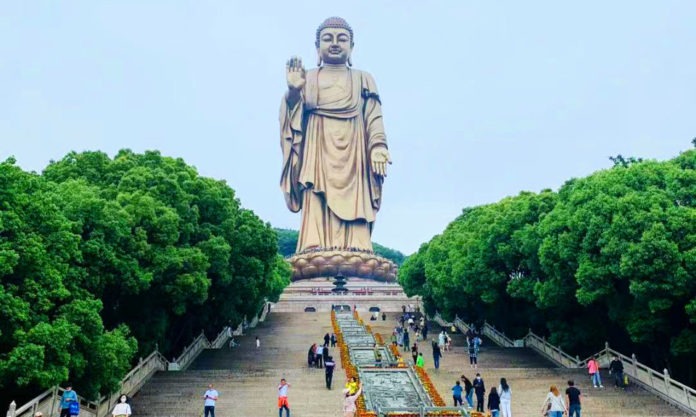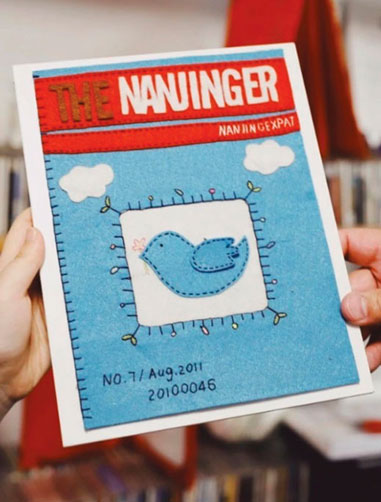“Life can only be understood backwards, and must be lived forwards.” [Soren Kierkegaard].
I Googled my old English teacher recently. She died in a road accident 20 years ago. A Dutch driver wandered into the path of the car in which she was riding.
In a shimmer, I was back in my 13 year-old-body, trying to make sense of the end of another life on the asphalt. It made me think of roads; of travel. The roads are a dangerous hotpot. Roads are hard to face, hard to stomach, hard to resist. We want to protect ourselves; to eliminate the risk of pain or hurt or despair.
Yet recently, I touched the Buddha’s feet. And that, has made all the difference.
Jiangsu Province is home to the former capital of China, Nanjing. Surrounded by the splendour of Purple Mountain, Qixia Mountain and Fang Mountain, and bisected by the meandering Yangtze River, Nanjing has no shortage of beauty spots to entice and delight.
However, as the temperature amps up to smelting, and the humidity reaches “hairdryer-in-a-Turkish-bath” levels here in the summer, it’s no harm to have a Plan B, C, D up the sleeve. And an “LMNOP”, just in case it’s raining also.
With that in mind, last month, I had the pleasure of visiting the Taihu (Lake Tai) area near Wuxi with a bunch of my favourite people; my students.
The lake area is as picturesque as any lake could be; water birds flit across the glassy surface, flowerbeds burst in an explosion of colour to one side, bamboo groves guard the inlets to one of the largest freshwater lakes of China on the other, where tiny two-man houseboats nestle.
During the day, these vessels fish the lake and supply local restaurants with mouthwatering fish, although the pollution concerns around Taihu mean that eating said fish is an act of risk-taking and blasé laissez-faire abandonment.
Nonetheless, the lapis lazuli mirror of the lake beneath the early summer sky reminded me of the joy of the first glimpse of Purple Mountain, in the valley I learned to think of as home.
Travel broadens the mind, perhaps, by reminding us of the beauty that shaped us.
Taihu is home to a jewel box of water-towns, scenic areas and The Lingshan Da Fo.
Lingshan Temple rests in the undulating hills of Yixing. Here, the Grand Buddha gazes benevolently down at pilgrims from a lofty 88 metres of height, perched upon a lotus flower, making it one of the tallest in the world. The first sight is breathtaking.
Downcast eyes and a smile that has heard worse tales and loves you still, the Buddha holds one hand aloft, palm open toward the approaching pilgrim.
Weighing in at a whopping 700 metric tonnes of bronze, this feat of art and engineering takes the breath away upon first sight.
Da Fo is magnificently huge. It was Buddha’s birthday on the day we visited, but a strange silence abided, not silent, yet so, given the sheer quantity of people. Incense and candlewax swathes the steps to Da Fo. We were awestricken.
Climbing the steps, fellow pilgrims knelt and bowed to the Enlightened One. We walked slowly. Quietly.
The Buddha was born a Prince, between 5,000 and 4,000BCE in India. His opulent early life, cosseted and consented, prepared him naught for the suffering and misery he discovered outside of his father’s palace. Encountering a sick man, an old man and a dying man, the Buddha, then known as Prince Siddhartha Gautama, renounced his princely trappings in pursuit of happiness.
What he eventually discovered was that it is only by embracing suffering that we can ever hope to be free. Wishing for that which is out of reach is a recipe for discontent, according to Buddha’s findings.
Unfortunately, the main ingredient in human ingenuity and innovation is imagination; this energy, desire and passion that fuels the madness of dreams and impossible endeavours.
Hope. Optimism. Faith. All of these things we must renounce if we are to be content in this world.
Suffering is part and parcel of the package, so tells the Buddha. His life story is a metaphor for this life journey, and the challenges we face upon its ofttimes rocky road. Illness, aging and death.
Following the snaking path up the base of Da Fo, before boarding the elevator to touch Da Fo’s feet; emerging out into the midday brightness. Da Fo seemed even taller, even grander. I felt even smaller.
I touched the smooth bronze surface of the statue, immersed in deep thought. One kid said “What are touching his toenail for? Touch his foot!”
Sharing laughter under Da Fo was a moment of joy, one of those we must grasp and enjoy in its very passing. So says Da Fo. This is the secret of contentment.
We climbed down. We broke bread together. We laughed more, lots more.
Outside of the temple, water villages are dotted along the Taihu Delta. Huishan Ancient Town is one of the most delightful nooks I’ve found since COVID burst onto the scene like a drunken uncle.
Rickety pavements run along the Beijing- Hangzhou canal which flows through the restored old town at the foot of Huishan Mountain. Teashops with sweet hawthorn and glazed cherry tomato sticks dot the walkway where willows dip to the cool waterway. There is a buzz, but it’s not busy. The arched bridges, whitewashed walls and granite brickwork bedecked with red lanterns, transport the visitor to a time past. No cars or scooters are allowed within the parameters. It is possible to stroll. Over bridges and beneath archways, down alleys and across tiny town squares.
It is good to walk slowly. One doorway reveals a Bonsai Garden. Another houses a portrait of Samuel Beckett, deep within the belly of a labyrinth of a tiny tearooms network.
Huishan Ancient Town hides baubles of beauty, inviting time to slow down; inviting the pedestrian by necessity, to take the foot off the accelerator a while, to enjoy the moment.
Nearby, Yixing houses the Museum for Clay Teapots originating in the 1400s. Through an arduous process of dominating chunks of rock, Yinxing Shi Fu’s mold the earth to their desire, creating some of the most exquisite, and, it must be said, expensive teapots in the world. In 2010, an Yixing teapot was auctioned for more than US$1.9 million. I urged the kids to be careful.
In the museum workshop, we worked with a lump of Yixing clay, which is no longer sanctioned for extraction from the earth. The supply remaining is all there is to be had. Under the watchful eye of the master, we craft our opus magmums.
My moldy looking pinch pot takes on a new sheen.
Jiangsu holds treasures we know not of.
The calendar days flip forwards. “I should be”, or “I would be”, niggle in the now dormant wanderlust part of the brain.
Some countries are opening up. I look at my pot, and I look at the pictures of low-key family reunions. I writhe and give thanks simultaneously.
I am like the falling cat with a slice of buttered toast taped to its back.
But Da Fo’s gaze is still upon me. Carpe that absolute diem, it says. Follow the road. Be where you are, and love it. The contentment in life is to be found in the moment, the passing flashes of happiness. The Buddha says embrace the suffering, but enjoy every moment of gladness to the max. There is no helmet that protects against life. The ability to experience exists only in the here and now.
Enjoy Jiangsu.











